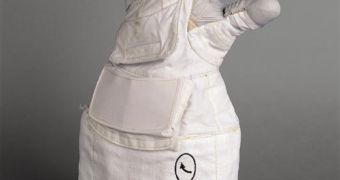On your marks! Get Set! Start knitting! NASA's Centennial Challenges will award the best spacesuit gloves project with $250,000.
It's the first ever Astronaut Glove Challenge and its purpose is to find the most innovative design for more flexible spacesuit gloves, as they are probably the most important part of the spacesuit from an astronaut's perspective. Besides pushing and pulling levers and buttons and handling power drills, astronauts use their hands more than their feet as their primary mode of "walking" around the International Space Station (ISS), a bit like monkeys using their arms in trees.
The first space suit gloves had three functions: to insulate the suit occupant and prevent heat loss, to shield the occupant from harmful solar radiation and to protect the astronaut from micrometeoroids, which could puncture the suit and depressurize it.
Unlike the first one-layered space gloves, modern gloves have two layers: a rubbery balloon-like layer surrounded by cloth to help keep the glove's shape and an outer shield that protects against micrometeoroids and orbital debris and insulates the hands against the extreme temperatures of space.
Being pressurized makes it a difficult task for astronauts to operate them in terms of accurately moving their fingers and for this reason, they perform hand-strengthening exercises to prepare for spacewalks, which can last six hours or more.
Bruises and pinches or bent fingernails are frequent after intensive mission exercises, so NASA has presented this challenge to everyone interested, not only the usual big aerospace companies, in winning the $250,000 grand prize ($200,000 for a "bladder restraint" glove competition and $50,000 for a "mechanical counterpressure" glove competition).
Six teams have entered the competition, which will be held on 2 and 3 May, and competitors will bring two identical gloves to the competition, which will be held at the New England Air Museum in Windsor Locks, Connecticut, US.
NASA will thoroughly measure, weigh and test them, especially with the "burst challenge", where the glove will be filled with water from a pump until it bursts a leak and then the organizers will measure the water pressure at the glove's breaking point, making this part of the competition basically a strength test for the gloves.
Then comes the flexibility test, where they will pressurize the glove to 0.29 atmospheres (4.3 pounds per square inch) and then will measure how well the glove flexes under pressure.
The final test will be that of endurance and the effects on the astronauts, where contesters themselves will have to squeeze a rubber ball after putting on the glove and every 5 minutes, the organizers will inspect the wearer for sign of bruising, peeling and other physical stress signs.
In the end, the team with the glove that scores highest in the three tests and also beats the existing spacesuit glove will take home the $200,000 prize.

 14 DAY TRIAL //
14 DAY TRIAL //